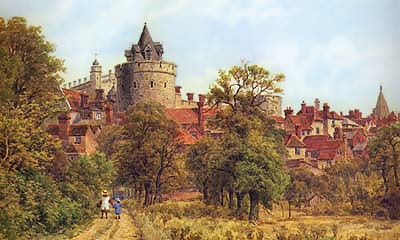
RBH Home
Maps & Travels
Articles
Legends
Towns & Villages
Castles & Houses
Churches
Biographies
Gentry
Family History
Odds & Ends
Mail David
 Windsor Castle
Windsor CastleGeorgian Phoenix
The first
and second Georges did not care for Windsor, but it was a favourite residence
of George III; but into such dilapidation was it allowed to fall that, in
1778, it was declared uninhabitable. It was therefore resolved to keep
what was standing from falling into ruins, but to build a new lodge on the
site of the house which Queen Anne preferred as a residence to the magnificence of the Castle.
The new residence, dubbed 'The Queen's
Lodge' was a long narrow building
with battlements facing north towards the old Castle walls. It was here
that Queen Charlotte lived when Fanny Burney, the author of "Evelina,"
afterwards known as Madame d' Arblay, was her maid-of-honour. According to
Miss Burney's diary, the life at Windsor must have furnished anything but
the excitement which is supposed to be the necessary element of court
life. At eight o'clock, the King and Queen attended prayers in the private
chapel. In the afternoon, the King and Queen and the princesses walked on
the terrace. By-the-by, on this terrace there is a sun-dial, which was the
cause of an interesting little incident. The King and the Duke of York
were, one day, walking on the terrace, when the King leant his arms on the
sun-dial. A sentry immediately came forward and respectfully, but
decidedly, informed the King that it was part of his duty to prevent any
person from touching the dial. The King was so charmed, that he commended
the soldier to his colonel and he was shortly afterwards promoted. Every
evening, there was music in the concert-room, the King being very fond of
Handel. In 1788, Miss Burney describes one of the King's attacks of
madness. The Prince of Wales and his brother, and several doctors and
equerries, sat up all night, whilst the King raved up and down in an
adjoining room and made occasional excursions in various apartments,
addressing wild accusations of neglect to each and every of his
attendants. Till at length, Mr. Fairly, one of them, led him gently, but
forcibly, away. During the King's illness, the Prince of Wales and Duke of
York lodged in the Castle and even held formal dinners there, whence it
may be deduced that formerly even the Royal kitchen in the Castle had
fallen into desuetude.
Although the Queen's Lodge was now the chief Royal residence, some
attention was paid to the restoration of the ancient Castle and, in 1800,
James Wyatt built a new staircase and also restored some apartments
looking on to the north terrace, whither the old King was removed during
his last attack of madness. On his death, he was laid under the chapel at
the east end of St. George's, in the vault which, in 1810, had been
erected for his daughter, Amelia.
During the reigns of George IV and William IV, James Wyatt's brother, Jeffry Wyatt, whom George IV knighted
and called Wyatville, continued the work of restoration and, gradually,
nearly all traces of the castle, as it was during the latter part of the
eighteenth century, disappeared. He raised the Round Tower to its present
height, designed the plan for the east and west sides of the Upper Ward,
raised the level of all the roofs, filled up the Brick Court with a grand
staircase and the Horn Court with the Waterloo Gallery, united the
stables, which were dotted throughout the Town, on Castle Hill, and built
the Brunswick Tower, and the York and Lancaster Tower. It is to
Wyatville's good taste and fine artistic perceptions that we owe the fact
that Windsor retains its characteristics of a medieval fortress, and has
not been converted into a stiffly symmetrical building, then so much
affected. George IV's favourite residence was the lodge near the Long
Walk, now known as the 'Royal Lodge,' but, two years before his death, he
removed to the castle, and his long illness kept him prisoner here till
his death. In the same room, later on called the 'Queen's Drawing Room,'
exactly seven years later, King William also died.
Part
8: St. George's Chapel
Edited from PH Ditchfield's "Bygone
Berkshire" (1896)
